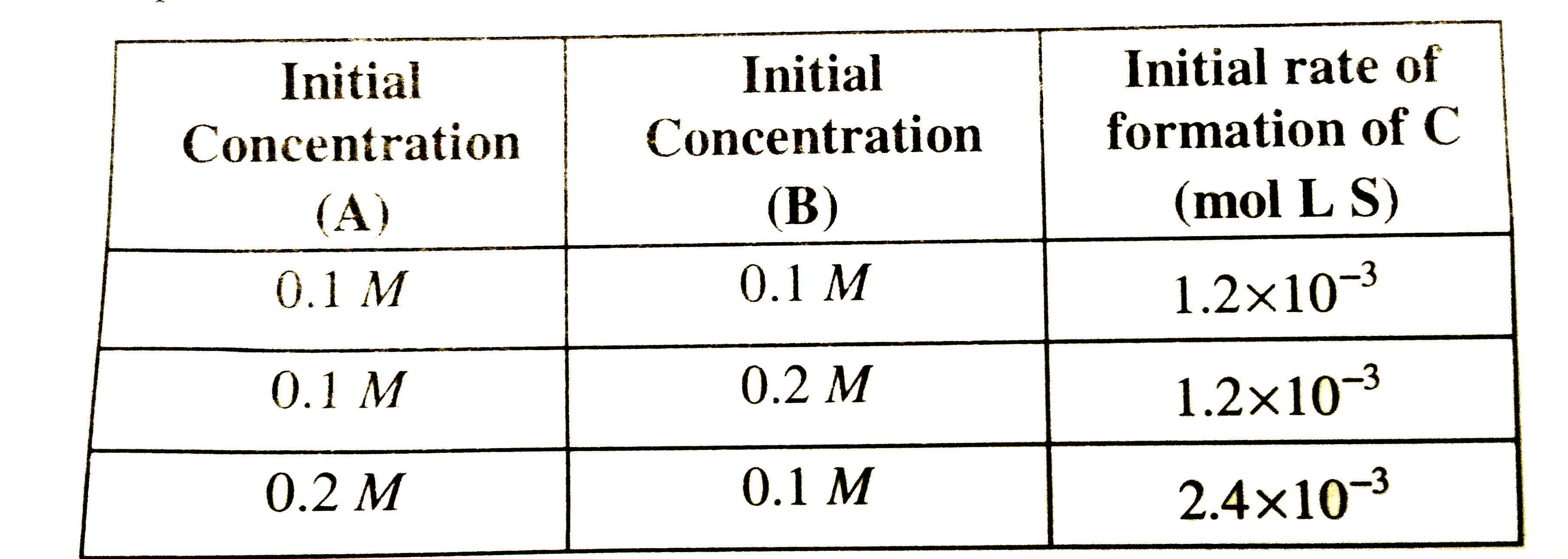For a reaction A+B→C+2D, experimental results were collected for three trials and the data obtained are given below:

The correct rate law of the reaction is
rate=k[A]0[B]2
rate=k[A][B]2
rate=k[A][B]
rate=k[A][B]0
The correct Answer is:A
rate=k[A]0[B]2
Topper's Solved these Questions
- CHEMICAL KINETICS Book:DISHA PUBLICATIONChapter:CHEMICAL KINETICS Exercise:EXERCISE 1 : CONCEPT BUILDER (TOPICWISE) (TOPIC 2: Order of Reaction and Half Life Period)
Explore 32 Videos
- CHEMICAL KINETICS Book:DISHA PUBLICATIONChapter:CHEMICAL KINETICS Exercise:EXERCISE 1 : CONCEPT BUILDER (TOPICWISE)(TOPIC 3 : Theories of Rate of Reaction)
Explore 17 Videos
- CHEMICAL KINETICS Book:DISHA PUBLICATIONChapter:CHEMICAL KINETICS Exercise:EXERCISE 2 : CONCEPT APPLICATOR
Explore 30 Videos
- CHEMICAL BONDING AND MOLECULAR STRUCTURE Book:DISHA PUBLICATIONChapter:CHEMICAL BONDING AND MOLECULAR STRUCTURE Exercise:EXERCISE-2: CONCEPT APPLICATOR
Explore 30 Videos
- CHEMISTRY IN EVERDAY LIFE Book:DISHA PUBLICATIONChapter:CHEMISTRY IN EVERDAY LIFE Exercise:Exercise
Explore 88 Videos
Similar Questions
For the non-stoichiometric reaction:
A+B→C+D, the following kinetic data were obtained in three separate experiments, all at 298K.

The order of the reaction is.
View SolutionFor the non-stoichiometre reaction 2A+B→C+D , the following kinetic data were obtained in three separate experiments , all at 298 K

The rate law for the formation of C is
View Solution
Knowledge Check
For the non-stoichiometric reaction:
2A+B→C+D, the following kinetic data were obtained in three separate experiments, all 298 K

The rate law for the formation of C is:AdCdt=k[A]BdCdt=k[A][B]CdCdt=k[A]2[B]DdCdt=k[A][B]2For a reaction ,A+B→C data is as follows :

the rate law for the reaction isARate =K[B]3BRate =[A]2[B]CRate =k[A]3DRate =[A][B]2Form the data given below for the reaction:A→B→ Products
the rate law expression is:ARate=k[A][B]BRate=k[A][B]2CRate=k[A]2[B]2DRate=k[A]2[B]
Consider the reaction 2A+B→C+D
Following results was obtained in experiments designed to study the rate of reaction"

a) Write the rate law for the reaction
b) Calculate the value of rate constant for the reactio.
c) Which of the following possible reaction mechanisms is consistent with the rate law found in (a) ?
I. A+B→C+E (slow)
A+E→D (fast)
IIgt B→C+E (slow)
A+E→F (fast)
A+F→D (fast)
View SolutionFor the reaction 2A+B→C, the values of ini concentrations are given in the table below. The rate law for the reaction is:

View SolutionFor the non – stoichiometre reaction 2A+B→C+D , the following kinetic data were obtained in three separate experiments, all at 298 K

The rate law for the formation of C is:
View SolutionFor a reaction 2P + Q → S , following data were collected. Calculate the overall order of the reaction. Also find out the reaction rate constant.

View SolutionFor the non-stoichiometric reaction 2A+B→C+D, The following data were obtained in three separate experiments, all at 298 K.

The rate law for the formation of C is:
View Solution

